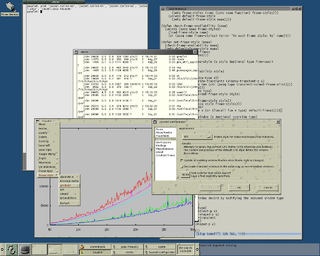
A context menu is a menu in a graphical user interface (GUI) that appears upon user interaction, such as a right-click mouse operation. A context menu offers a limited set of choices that are available in the current state, or context, of the operating system or application to which the menu belongs. Usually the available choices are actions related to the selected object. From a technical point of view, such a context menu is a graphical control element.

An X window manager is a window manager which runs on top of the X Window System, a windowing system mainly used on Unix-like systems.

A stacking window manager is a window manager that draws all windows in a specific order, allowing them to overlap, using a technique called painter's algorithm. All window managers that allow the overlapping of windows but are not compositing window managers are considered stacking window managers, although it is possible that not all use exactly the same methods. Other window managers that are not considered stacking window managers are those that do not allow the overlapping of windows, which are called tiling window managers.

ratpoison is a tiling window manager for the X Window System primarily developed by Shawn Betts. ratpoison is written in C; Betts' StumpWM re-implements a similar window manager in Common Lisp. The user interface and much of their functionality are inspired by the GNU Screen terminal multiplexer.

Metacity
was the default window manager used by the GNOME 2 desktop environment until it was replaced by Mutter in GNOME 3. It is still used by GNOME Flashback, a session for GNOME 3 that provides a similar user experience to the Gnome 2.x series sessions.

A window manager is system software that controls the placement and appearance of windows within a windowing system in a graphical user interface. Most window managers are designed to help provide a desktop environment. They work in conjunction with the underlying graphical system that provides required functionality—support for graphics hardware, pointing devices, and a keyboard, and are often written and created using a widget toolkit.

USS Sawfish (SS-276), a Gato-class submarine, was a ship of the United States Navy named for the sawfish, a viviparous ray which has a long flat snout with a row of toothlike structures along each edge. It is found principally in the mouths of tropical American and African rivers.

StumpWM is a tiling window manager that was created when developer Shawn Betts found ratpoison growing increasingly large and "lispy". Intended as a successor to ratpoison, StumpWM is released under the terms of the GNU General Public License, version 2 (GPLv2).
The knifetooth sawfish, also known as the pointed sawfish or narrow sawfish, is a species of sawfish in the family Pristidae, part of the Batoidea, a superorder of cartilaginous fish that includes the rays and skates. Sawfish display a circumglobal distribution in warm marine and freshwater habitats. Their extant biodiversity is limited to five species belonging to two genera. The sawfishes are characterised by the long, narrow, flattened rostrum or extension on their snout. This is lined with sharp transverse teeth, arranged in a way that resembles the teeth of a saw. It is found in the shallow coastal waters and estuaries of the Indo-West Pacific, ranging from the Red Sea and the Persian Gulf to southern Japan, Papua New Guinea and northern Australia. It is the only living member of the genus Anoxypristis, but was previously included in the genus Pristis. Compared to that genus, Anoxypristis has a narrower rostral saw with numerous teeth on the distal part and no teeth on the basal one-quarter. This endangered species reaches a length of up to 3.5 metres (11 ft).

The largetooth sawfish is a species of sawfish, family Pristidae. It is found worldwide in tropical and subtropical coastal regions, but also enters freshwater. It has declined drastically and is considered critically endangered.

The smalltooth sawfish is a species of sawfish in the family Pristidae. It is found in shallow tropical and subtropical waters in coastal and estuarine parts of the Atlantic. Reports from elsewhere are now believed to be misidentifications of other species of sawfish. It is a critically endangered species that has disappeared from much of its historical range.

The longcomb sawfish, narrowsnout sawfish or green sawfish is a species of sawfish in the family Pristidae, found in tropical and subtropical waters of the Indo-West Pacific. It has declined drastically and is now considered a critically endangered species.
Extended Window Manager Hints, a.k.a. NetWM or Net WM, is an X Window System standard for window managers. It defines various interactions between window managers, utilities, and applications, all part of an entire desktop environment. It builds on the functionality of the Inter-Client Communication Conventions Manual (ICCCM).
wmctrl is a command used to control windows in EWMH- and NetWM-compatible X Window window managers. Some of its common operations are list, resize, and close window. It also has the ability to interact with virtual desktops and give information about the window manager. wmctrl is a command-line program, however, it has some functions that allow the mouse to select a window for an operation.
This article compares variety of different X window managers. For an introduction to the topic, see X Window System.

Pristis is a genus of sawfish of the family Pristidae. These large fish are found worldwide in tropical and subtropical regions in coastal marine waters, estuaries, and freshwater lakes and rivers. Sawfish have declined drastically and all species are considered seriously threatened today.

awesome is a dynamic window manager for the X Window System developed in the C and Lua programming languages. Lua is also used for configuring and extending the window manager. Its development began as a fork of dwm. It aims to be extremely small and fast, yet extensively customizable. It makes it possible for the user to manage windows with the use of keyboard.












